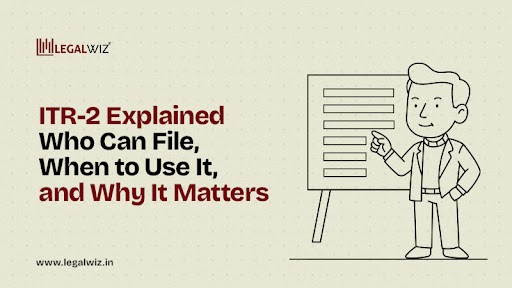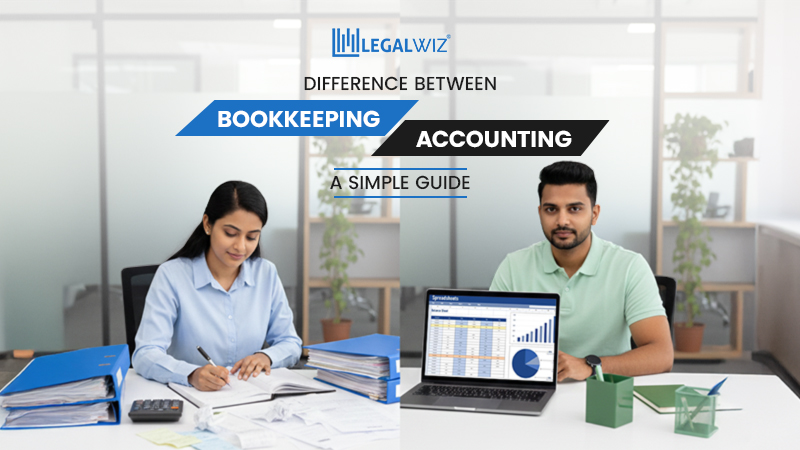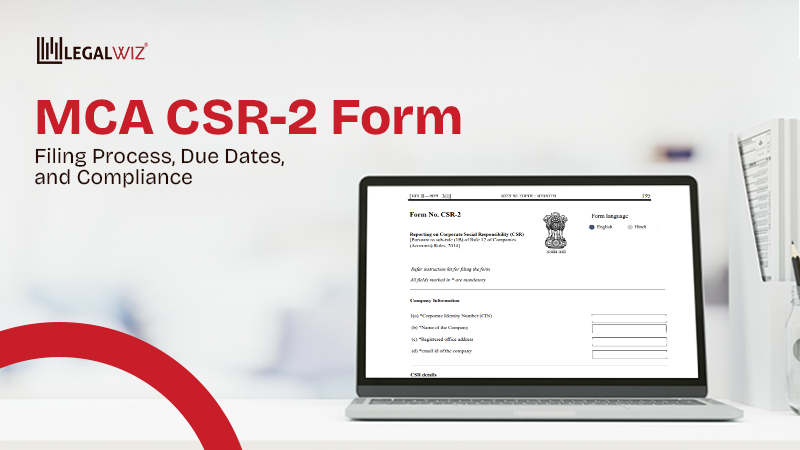ITR-2 Explained: Who Can File, When to Use It, and Why It Matters
Think of ITR-2 as the “slightly fancier cousin” of ITR-1. If you’ve already read our guide on ITR-1 (Sahaj) to know who can file it and how it works, you know that ITR-1 is perfect for the simple stuff, salary, bank interest, and one house property.
But what if your finances go beyond that? Multiple houses, dividends, or capital gains from selling stocks or property? Maybe you’ve got foreign assets or even a directorship in a company? Well, congratulations, you’ve officially graduated from the ‘chai and samosa’ club (ITR-1) to a slightly bigger buffet, and that’s where ITR-2 steps in.
Many taxpayers miss this switch during the ITR filing season and either pick the wrong form or stick to ITR-1 when they’ve outgrown it. The result? Defective returns, notices from the tax department, and a round two of filing that could’ve been avoided.
This guide cuts through the jargon and tells you:
- Who really needs to file ITR-2 (and why not everyone does).
- When it becomes mandatory (even if you think ITR-1 still fits).
- Why filing ITR-2 correctly is more than ticking a compliance box, it’s the safety net that keeps your tax record clean and future loan applications smooth.
By the end, you’ll know whether ITR-2 is your rightful tax partner this season, and how to avoid the common traps most taxpayers fall into.
What Exactly is ITR-2?
If ITR-1 is your go-to cup of chai, simple, quick, and made for everyday taxpayers, ITR-2 is the premium brew with extra flavors. It’s designed for individuals and Hindu Undivided Families (HUFs) whose finances stretch beyond the basics of salary, interest income, and one house property.
Think of it as the form for taxpayers who have “a little extra going on”, whether that’s:
- Capital gains from selling shares, mutual funds, or property.
- Multiple house properties (because one home just isn’t enough).
- Foreign income or assets that bring an international twist to your tax story.
- Dividends that keep rolling in, even if you’re not running a business.
But here’s the fine print: ITR-2 isn’t for those earning from business or professional activities. The moment you have business income, you graduate to ITR-3.
Takeaway: Think of ITR-2 as ITR-1’s smarter, globe-trotting cousin—the one who invests, sells, buys, and travels abroad, but doesn’t run a company.
Who Can File ITR-2? (Eligibility)
Not everyone gets an invite to the ITR-2 party—it’s reserved for taxpayers whose finances go beyond the “salary-only” lane. If your income sources are a buffet rather than a single dish, this is your plate. Here’s who qualifies:
| Eligible Taxpayers | What It Means | Quick Example |
| Salaried individuals with capital gains | Earned profits from selling shares, mutual funds, bonds, or property. | Booked profits in the stock market or sold that old flat? ITR-2 is waiting for you. |
| People with more than one house property | Income from owning two or more houses, even if one is vacant. | One home sweet home = ITR-1. More than one = upgrade to ITR-2. |
| Individuals with foreign income or assets | Income from abroad or ownership of assets outside India. | If your money travels abroad, so does your tax form. |
| Agricultural income over ₹5,000 | Farm income exceeding the basic ₹5,000 threshold. | A little harvest is fine for ITR-1, but big yields call for ITR-2. |
| Earning dividends | Multiple or high-value dividend incomes make your tax situation complex. | Your portfolio’s popping with dividends? ITR-2’s your plate. |
When your income sources look like a buffet instead of a single dish, ITR-2 is the plate you need to hold it all together.
Who Cannot File ITR-2? (Non-Eligibility)
While ITR-2 covers a wide range of taxpayers, it’s not a one-size-fits-all form. If your income type doesn’t fit the criteria, using ITR-2 can land you in trouble with a defective return notice. Here’s who should avoid ITR-2 and what form they should use instead:
| Not Eligible Taxpayers | Why They’re Out | Quick Tip |
| Individuals or HUFs with business or professional income | ITR-2 does not apply if you earn from business, freelancing, or professional services. You must use ITR-3 instead. | “Run a shop, consultancy, or side hustle? ITR-2 will show you the exit door—ITR-3 is your ticket.” |
| Taxpayers eligible for ITR-1 (Sahaj) | If your income is only from salary/pension, one house property, and basic interest (≤ ₹50 lakh), you don’t need ITR-2. | “Keep it simple. If your tax plate is just salary + savings, ITR-1 is enough to serve you.” |
Filing the wrong form doesn’t just delay your refund—it can make your return invalid, trigger tax notices, and lead to penalties. Always double-check which ITR applies to you before hitting submit.
When Should You Use ITR-2? (The Right Scenarios)
Think of ITR-2 as the form you graduate to when your income story gets a bit more complex than just “salary + savings interest.” The moment your money starts moving in multiple directions, ITR-1 simply can’t keep up. Here’s when you should reach for ITR-2:
- Sold property or investments? Any capital gains or losses from selling shares, mutual funds, bonds, or real estate need the extra space ITR-2 provides.
- Own more than one house? If you’ve got a second home (whether rented out or sitting empty), ITR-1 isn’t built for that.
- Foreign connections? Holding a bank account abroad, owning overseas shares, or earning a salary outside India makes ITR-2 mandatory; you must disclose these details.
- Dividends crossing the basic limit? If your dividend income goes beyond the basic exemption slab or comes from multiple sources, it needs proper reporting here.
Real-Life Example:
Meet Rohan, your typical 9-to-5 professional who thinks his taxes are straightforward… until this year:
- Salary: A fixed monthly paycheck from his IT job (easy enough for ITR-1).
- Stock sale: Sold shares worth ₹8 lakh, making a tidy capital gain.
- Extra property: Rents out his second apartment for side income.
Now, if Rohan sticks to ITR-1, thinking “salary is my main income,” he’s in for trouble. That form can’t handle capital gains or multiple properties, which means:
- His return could be marked defective or invalid, forcing him to refile.
- A tax notice might land in his inbox later.
- Future loan or visa applications could hit a snag because of filing errors.
Moral of the story: ITR-2 isn’t just a fancier form; it’s the right safety net when your income isn’t one-dimensional.
Why Filing ITR-2 Matters (And How It Saves You Trouble)
Filing the right ITR form isn’t just a bureaucratic checkbox; it’s what keeps your tax record clean, your refunds on track, and the Income Tax Department off your back. When your income mix calls for ITR-2, skipping it is like boarding the wrong flight; you’ll waste time, energy, and money fixing the mess later. Benefits of filing ITR
Here’s why choosing ITR-2 (when applicable) matters big time:
- Smooth processing & quick refunds: The system matches your income details with the right form. A mismatch (like filing ITR-1 when you need ITR-2) can stall your refund or send your return to the “defective” pile.
- Avoids tax notices & penalties: Filing the wrong form may trigger tax notices or even penalties for misreporting income.
- Accurate reporting of capital gains: Selling property, stocks, or mutual funds needs detailed disclosure. ITR-2 gives you the space to report it properly and avoid future scrutiny.
- Keeps your financial record clean: Incorrect filings can raise red flags during loan approvals, visa processing, or future assessments.
- Peace of mind: No re-filing hassles, no late-night stress sessions, wondering if the tax department will come knocking.
Skipping ITR-2 when you need it is like taking a train to Goa when your ticket says Manali; you’ll eventually get there, but not without delays, confusion, and unnecessary extra costs.
Key Documents You’ll Need for ITR-2
Before you start filing, think of these documents as your tax toolkit—miss one, and the whole process can wobble like a chair with a missing leg. Gather these first to make your ITR-2 filing smooth and stress-free:
| Document Type | What It’s For |
| PAN, Aadhaar & Bank Details | Mandatory for identity verification and receiving refunds. |
| Form 16, AIS & TIS | Shows your salary, TDS, and income information reported to the tax department. |
| Broker Statements & Property Sale Documents | Need to calculate capital gains or losses from shares, mutual funds, or real estate sales. |
| Rent Agreements, Property Tax Receipts | If you own multiple properties or earn rental income. |
| Deduction Proofs (80C, 80D, etc.) | Helps you claim tax-saving benefits on investments and insurance. |
| Foreign Income or Asset Details | Required if you have overseas bank accounts, shares, or earnings. |
Pro Tip: Keep these docs in one folder before you log in to file; it’s the secret hack to avoiding midnight document hunts during the filing deadline rush.
If all these different ITR forms have you scratching your head, don’t worry—you’re not alone. Choosing the right form is the first (and most important) step in ITR filing. To make it easier, check out our ITR-1 to ITR-7 form guide, which walks you through each form so you know exactly which one fits your income type and how to avoid costly filing mistakes.
What Are the Modes of Filing ITR-2?
When it comes to ITR filing, the Income Tax Department offers two convenient ways to get it done:
1. Filing ITR-2 Online:
- The most popular method is where you log in to the Income Tax Portal and fill out your return directly.
- Ideal for those who prefer a quick, guided process without downloading anything extra.
2. Filing ITR-2 via Offline Utility:
- You can download the Java or Excel utility, fill in your return offline, and then upload the completed file to the portal.
- Handy if you like working without an internet connection or want to take your time before submitting.
Think of it as choosing between ordering food online or cooking it yourself—you’ll eat either way, but the experience is a little different.
Want the full breakdown with screenshots and pro tips? Check out our detailed guide → How to File ITR-2 Online (Step-by-Step).
Final Thoughts – Choosing the Right ITR is Half the Battle
While filing Income Tax Return, picking the correct ITR form isn’t just about ticking a box—it’s about keeping your tax record spotless, refunds on time, and the IT department off your back.
ITR-2 is your go-to when your financial life gets a little “extra”—multiple houses, stock sales, foreign income, or chunky dividends. File the wrong form, and you risk notices, penalties, or a second round of filing you definitely don’t want during deadline week.
Bottom line: The right form = fewer errors, fewer headaches, and faster refunds.
Want zero guesswork and a stress-free tax season? Let the experts at LegalWiz.in handle your ITR-2 filing while you sit back and sip your chai.
Frequently Asked Questions
Is filing ITR-2 mandatory if I already filed ITR-1?
Not if ITR-1 covers all your income sources. But if you’ve got extra toppings on your income pizza, like capital gains, multiple houses, or foreign assets, you need ITR-2. Filing the wrong form could mean notices and a redo of your return.
What happens if I don’t file ITR-2 even when required?
Skipping ITR-2 is like ignoring a traffic signal; you might get away once or twice, but sooner or later, you’ll face penalties, tax notices, or even delayed refunds.
Can I switch from ITR-1 to ITR-2 mid-season?
Absolutely! If you discover extra income sources after starting your ITR-1 draft, you can switch to ITR-2 before submission. Think of it as upgrading from an auto-rickshaw to a cab when your luggage doesn’t fit.
How do I know if ITR-2 is right for me?
Ask yourself: “Do I have just a salary and one house property?” If yes, ITR-1 works. If not, capital gains, foreign income, or multiple properties, you’re on team ITR-2. When in doubt, check our ITR Form Guide (ITR-1 to ITR-7) or let a tax expert handle it.

Sapna Mane
Sapna Mane is a skilled content writer at LegalWiz.in with years of cross-industry experience and a flair for turning legal, tax, and compliance chaos into clear, scroll-stopping content. She makes sense of India’s ever-changing rules—so you don’t have to Google everything twice.







